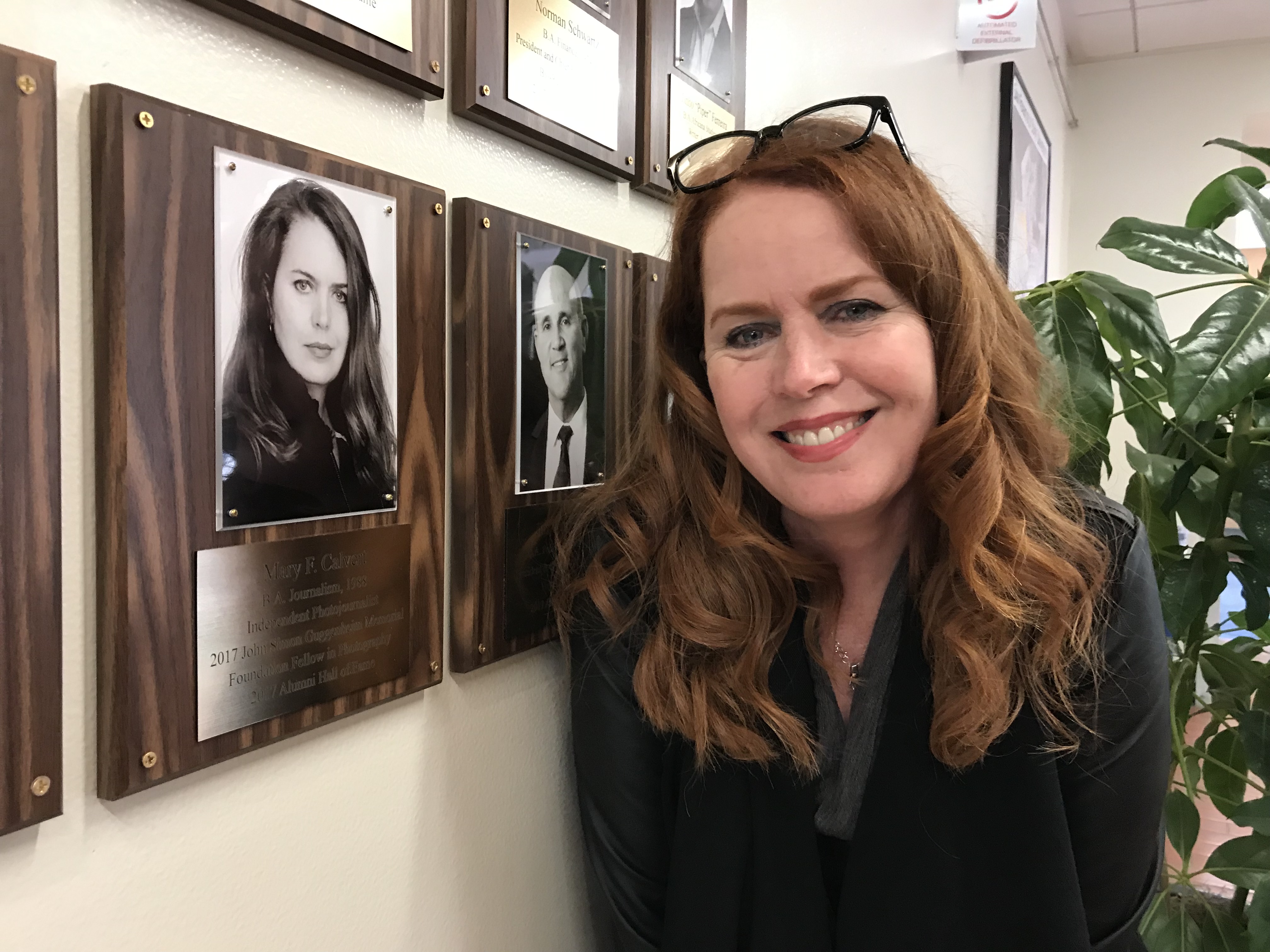Alumni earn Pulitzer Prize honors

Mary Calvert stands by her photo in the Administration Building during a visit to campus in April 2019.
Photo by Kim Komenich
The Journalism Department is proud to announce that three photojournalism alumni were honored in the the 2020 Pulitzer Prize competition.
Mary F. Calvert (’88), a freelance photographer, was named a finalist in Feature Photography for work published by The New York Times and Yahoo News that looks at male sexual assault survivors in the armed forces and the lasting effects of trauma on them and their families. This is the third time Calvert was honored as a finalist for a Pulitzer Prize.
For the past six years Calvert has focused her lens on the underreported abuse of women and men in the U.S. Armed Forces. She has received numerous honors for this work, including 2nd place, Contemporary Issues in the 2018 World Press Photo Contest and 1st Prize, Long Term Projects in the 2016 World Press Photo Contest. One chapter of the project, “Prisoners of War: Male-on-male Sexual Assault in America’s Military” was awarded the 2016 Getty Images Grant in Editorial Photography. Calvert is a 2017-2018 John Simon Guggenheim Memorial Foundation Fellow in Photography.
Calvert has won the Robert F. Kennedy Journalism Award twice and is a two-time Pulitzer Prize finalist in Feature Photography.
“Mary Calvert continues to go to impossible places to do extremely difficult stories,” said Kim Komenich, associate professor of journalism and head of the photojournalism program at SFSU. “I can think of no other photographer who does such thoughtful, empathetic work on communities that aren’t even on the mainstream press’s radar.”
Calvert showed some of the images during a presentation to SF State journalism students in April 2019. She has spoken to classes at SF State on numerous occasions. In 2017, she was inducted in the SFSU Alumni Hall of Fame and in 2013 she was named Alumna of the Year by the Journalism Department.
Ken Kobré, professor emeritus and Calvert’s photojournalism professor, noted that Calvert uses her ears, as well as her eyes, in documenting the stories she shoots.
“Mary listened to survivors’ stories– and then turned their pain into visual evidence,” Kobré said in an email interview. “Few stories could be as difficult to photograph as those that show visually the long-term effects of sexual assault.”
Michael Robinson Chávez (‘94), a staff photographer for The Washington Post, was part of the team that won the Pulitzer Prize for Explanatory Journalism for a groundbreaking series that the judges said, “showed with scientific clarity the dire effects of extreme temperatures on the planet.”
“Michael’s contribution to the Washington Post’s team Pulitzer Prize for Explanatory Journalism for its series on climate change demonstrates his ability to photograph difficult assignments,” said Kobré, who taught him as well. “His pictures from Siberia are already strong as individual images, but they also help to drive the story forward. One example is his photo of Native Yakutian horses grazing near the wreckage of a Soviet-era helicopter near Zyryanka. The area had been part of an airport in the 1980s but has reverted to pasture due to thawing permafrost.
He was also named Photographer of the Year by Pictures of the Year International in 2020.
You can view Robinson Chavez’s award-winning work here and here.
He, along with Joel Angel Juarez (‘18) was also part of The Washington Post team that was named a finalist in Breaking News Reporting for coverage of back-to-back mass shootings in El Paso, Texas, and Dayton, Ohio, that contextualized these events for a national audience.
Juarez’s photograph captures girls on an El Paso soccer team one week following the murders. “He was able to get access and make surprisingly visually graphic images under difficult emotional conditions,” Kobré said.
“I remember Angel as an outstanding student who was eager to learn,” Kobré recalled. “I recently reviewed pictures he took during Photo II. I enjoyed seeing how carefully he framed each image. He also was clearly interested in covering news. He never seemed afraid of meeting new people or photographing difficult situations."
“In a note he wrote to me as one of his first semesters began, he revealed, ‘My biggest fear is not knowing how close I can get to a subject. However, I still shoot it, but that fear is still in the back of my mind.’”
Kobré noted that Juarez’ willingness to overcome his fears and get close to his subjects, exemplifies the spirit that has made him a prize-winning photojournalist.
You can view Joel Angel Juarez’s contribution here.